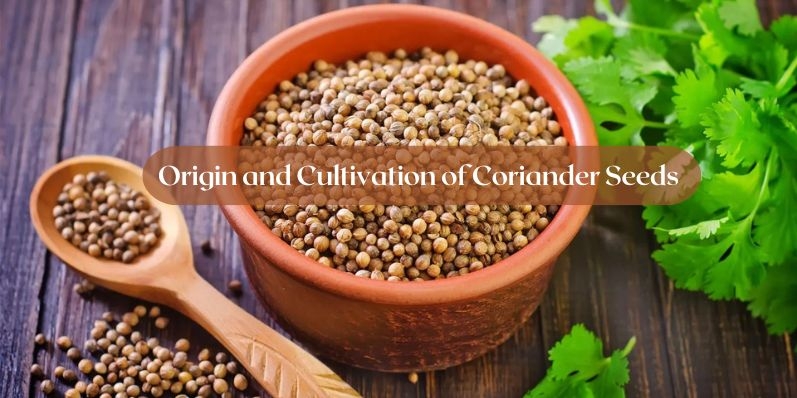
28-09-2023
Origin and Cultivation of Coriander Seeds
- Admin
Coriander seeds, scientifically known as Coriandrum sativum, are a versatile spice that has been an integral part of global cuisine for centuries. These tiny, aromatic seeds are not only celebrated for their culinary applications but also for their historical significance and medicinal properties. In this article, we will embark on a journey to explore the fascinating origin and cultivation of coriander seeds, tracing their rich history from antiquity to their widespread use in kitchens around the world.
Ancient Origins of Coriander
The story of coriander seeds begins in the Mediterranean region and ancient Egypt, where they were cultivated over 3,000 years ago. Archaeological evidence shows that coriander was used by ancient Egyptians in cooking and as an ingredient in their embalming rituals. The seeds were placed in pharaohs' tombs as a symbol of eternal love.
Cultivation of Coriander
Coriander is an annual herb with delicate, feathery leaves known as cilantro, which are also widely used in cooking. The plant requires specific growing conditions to thrive.
Climate: Coriander is a cool-season herb and prefers a temperate climate. It grows best in temperatures ranging from 50 to 85 degrees Fahrenheit (10 to 30 degrees Celsius).
Soil: Well-draining soil rich in organic matter is ideal for coriander cultivation. It thrives in soil with a pH level between 6.2 and 6.8.
Sunlight: Coriander prefers partial to full sunlight, although it can tolerate some shade.
Watering: Consistent and even watering is crucial for healthy coriander growth. The soil should always be kept moist but not damp.
Cultivation Process
The cultivation of coriander seeds involves several key steps:
Seed Sowing: Coriander seeds are sown directly in the ground or in containers. They should be spaced about 6 to 8 inches apart to allow sufficient room for growth.
Germination: Coriander seeds typically germinate within 7 to 14 days when provided with proper moisture and temperature conditions.
Thinning: Once seedlings reach a height of 2 to 3 inches, thinning is necessary to ensure adequate space for growth. Thinned seedlings can be used in cooking as young cilantro leaves.
Harvesting Leaves: The cilantro leaves can be harvested once they reach a desirable size, usually within 3 to 4 weeks of germination. Harvesting the plant frequently promotes it to grow additional leaves.
Harvesting Seeds: Coriander seeds are harvested when the plant bolts, which means it produces flowers and then seeds. This typically occurs 45 to 90 days after sowing, depending on growing conditions.
Drying: After harvesting, the seeds are typically left to dry on the plant before being collected. Once they are fully dried, they can be stored for future use.
Global Cultivation and Varieties
Coriander seeds are grown in various regions around the world due to their popularity in diverse cuisines. Some of the largest producers of coriander seeds include India, Russia, Morocco, and Indonesia. Each region's climate and soil conditions can influence the flavor and aroma of the coriander seeds produced there, leading to subtle variations in taste.
Indian Coriander: India is one of the world's largest producers of coriander seeds. Indian coriander seeds are known for their citrusy, slightly sweet flavor and are a staple in Indian curries and spice blends like garam masala.
Russian Coriander: Russian coriander seeds tend to be milder and less citrusy than their Indian counterparts. They are often used in European cuisine and spice blends like pickling spices.
Moroccan Coriander: Moroccan coriander seeds are prized for their intense, earthy flavor. They are a key ingredient in Moroccan spice blends like ras el hanout and are used in dishes such as couscous and tagines.
Indonesian Coriander: Indonesian coriander seeds have a unique flavor profile with hints of citrus and spice. They are commonly used in Indonesian, Malaysian, and Thai cuisine, particularly in dishes like rendang and green curry.
Medicinal and Culinary Uses
Coriander seeds are celebrated not only for their culinary versatility but also for their potential health benefits. In traditional medicine, they have been used to address digestive issues, reduce inflammation, and alleviate symptoms of arthritis. These seeds contain essential oils, antioxidants, and dietary fiber, which contribute to their medicinal properties.
In the culinary world, coriander seeds are an essential spice in many dishes. They are used whole or ground to add flavor and aroma to curries, soups, stews, pickles, and baked goods. The seeds have a warm, citrusy, and slightly nutty flavor that complements a wide range of ingredients and cuisines.
Conclusion
The journey of coriander seeds from their ancient origins to their present-day global cultivation is a testament to their enduring popularity and cultural significance. These versatile seeds have made their mark not only in the kitchen but also in history, with references dating back thousands of years.
Whether you're savoring the citrusy notes of Indian coriander in a curry, enjoying the earthy aroma of Moroccan coriander in a tagine, or exploring the unique flavors of Indonesian coriander in a Thai curry, coriander seeds continue to play a vital role in diverse culinary traditions worldwide. As we appreciate the rich history and cultivation of coriander seeds, we can also celebrate their enduring presence in the global spice pantry and their contributions to the rich tapestry of global cuisine.